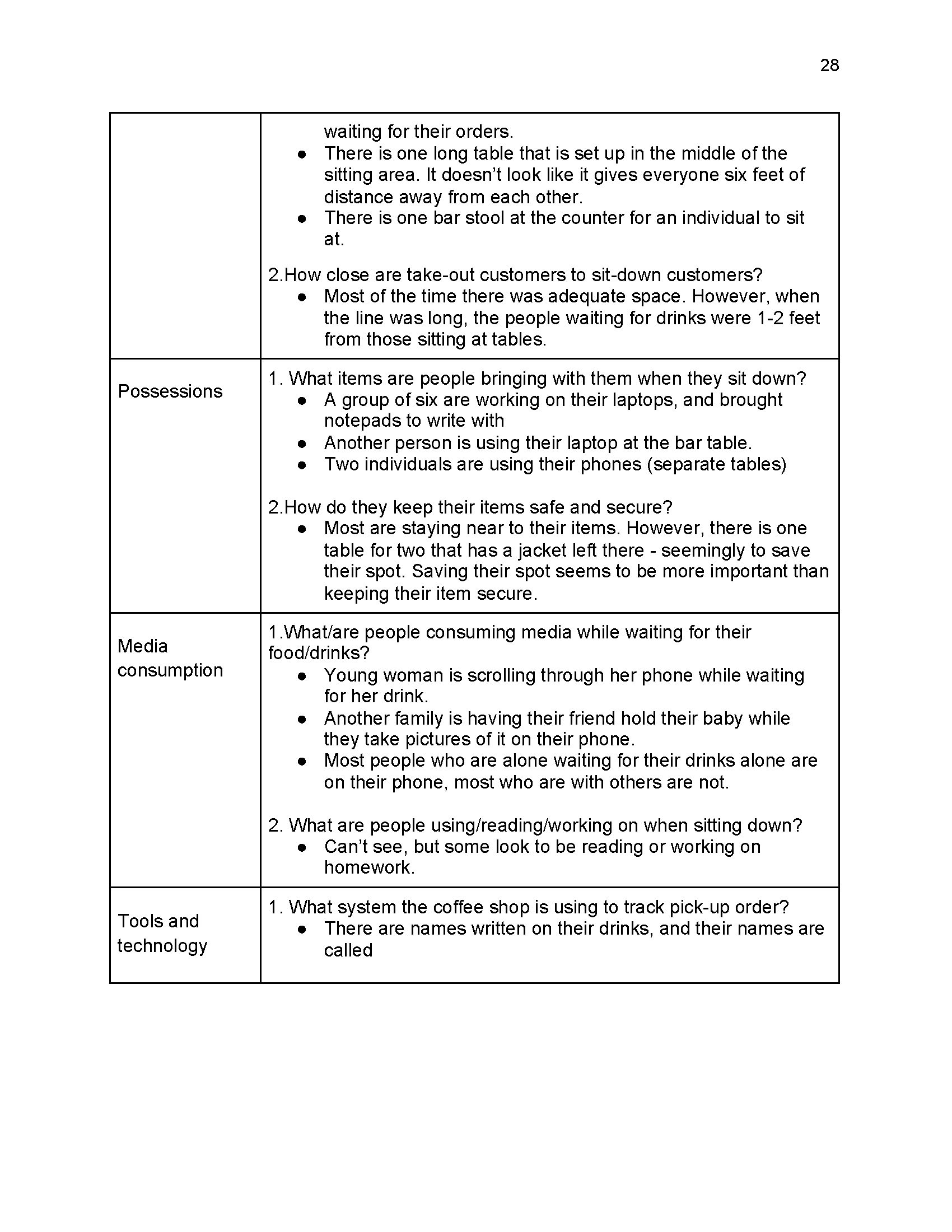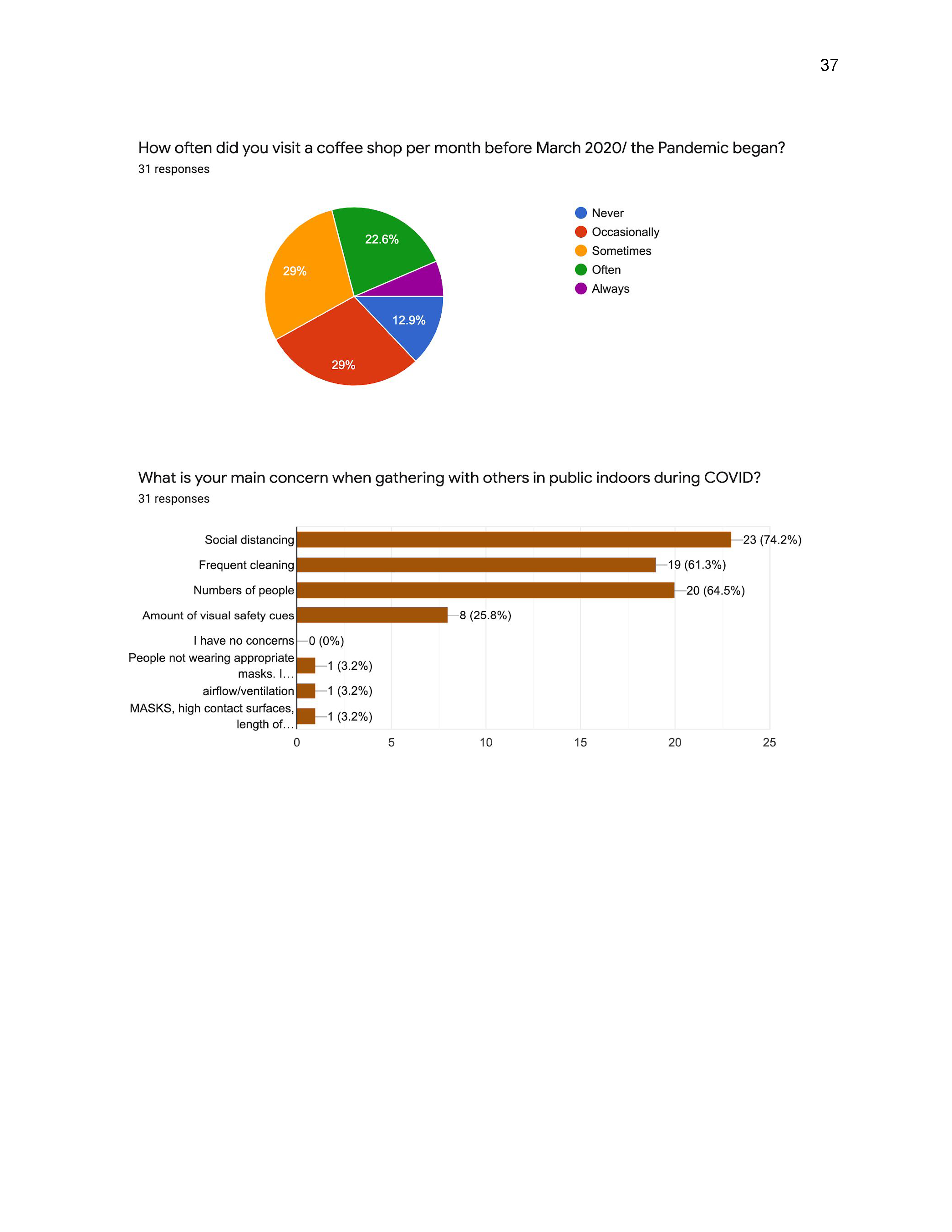JavaHeads
Design Thinking Studio
TECHIN521
2020 Autumn
We are three passionate coffee-lovers who miss scenes like the one above. We know that coffeeshops are is not just about drinking coffee in the same way a bar isn’t just about beer - or a library isn’t just about books. Coffee shops unite and strengthen communities. This “coffee culture” is a major symbol of the Seattle area, as well as an important meeting place for locals to socialize and gather professionally.
However, COVID-19 has changed all that…
Who are we?
Like most other indoor establishments, coffee shops were hit hard from COVID-19 lockdowns. Not only were some local coffee shops forced to shut their doors, but the community had nowhere safely to meet . Coffee shops are also a great source of social equity since they usually provide free WIFI to patrons. With many isolated from their social circles, crammed inside their homes, or out of a job, coffee shops were unable to be the productive escape they normally were.
As members of Design Thinking Studio at GIX, we sought to apply the course content to the following:
How can independent coffee shops allow social/professional gatherings to occur, safely, during COVID-19?
What we are trying to solve?
The Design Thinking Process
In contrast to my typical working experience, the process of Design Thinking starts with an in-depth analysis of the issue before any attempts to solve it. This investigative period is crucial to understanding both the problem and the people it effects. The reason is not just due to constraints, but that the perceived solution may actually have negative effects (ex. how Tom’s giving away free shoes negatively impacted the local economy). Our assignment was to select a place of business and investigate how COVID had effected them. Since our team shared a love of coffee, we chose coffee shops as our location.
Our research was split into three parts:
Secondary Research
In-person Field Study
Survey
After each part, we were to assess our design question and update our requirements according to the insights we uncovered.
Role:
Having experience in Project Management, I volunteered to take the lead on planning and communicating the requirements of assignments so we could get the best results from them.
Also, having a minor in Entrepreneurship and experience working at a start-up, I was able to provide unique insights at each step of the way. I used this insight to help focus our team on which solutions we were best equipped to resolve, and which ones would have the greatest impact to our stakeholders.
Secondary Research
Coming from both a Political Science and business background, I was able to help my team navigate beyond basic Google (e.g. scholarly articles, UW library site) and curate data that showed there was indeed an issue somewhere that needed to be addressed.
Since we were only doing research on how COVID and Coffee Shops interacted, it was difficult to not jump straight into the identifying problems that looked “solvable”.
(Below are examples of our slides research)
For every issue we found that coffee shops encountered, we were forced to drop our ego and recognize that some of the issues were either minor or not existent. For example, we initially wanted to focus on all coffee shops. Yet we realized through research that drive thru chains were less effected - simply because of how food/drink was delivered - and many large chain coffee shops had already established online ordering systems.
Our study showed that coffee patronage was down 30% due to COVID.
However, it also showed that people stayed in independent coffee shops longer than they did before COVID.
These tidbit from our research inspired us to focus on independent coffee shops.
In-person Field Study
After our secondary research, we were tasked with conducting on-site visits to our chosen locations.
Even though I visited the local coffee shops often, this time it would be different: we would simply observe.
HOLD IT! NOT YET.
In order to maximize the visit and its insights, we were trained on skills that focused the process. This training culminated in a Field Study Plan that prepared us with a worksheet of questions that helped us organize exactly what we saw.
The field study was eye opening in that it reinforced the similarities between before COVID and the present. However, the key differences were what made it most effective.
During this research, we all saw how the inside seating had no organization to it. It was 6ft apart, but it was still first come first serve. This realization would eventually create the design question mentioned above.
(Example of my report below)
Survey
With valuable insight gained from the on-site visit, we now needed to recruit a wider range of individuals to speak to.
This is where the survey came in.
After additional training on the impact of question wording, conscious and unconscious bias, and the importance of asking relevant questions, we created a survey on google docs. We learned in PolySci about similar biases and inaccuracies in polls, but to apply it to an industry was a new and exciting challenge. I used this experience to help my team reveal things in their questions that would help us further sharpen our design question.
When we had some difficulty recruiting individuals, I utilized forums for coffee drinkers (r/coffee) and survey sites (surveyswap.io). Though anonymous, it was great to get responses from strangers.
Investigation and Requirements Report
After completing our survey, we complied it into a 38 page investigative report. There we cross-examined our three sources of research, and created requirements that our eventual solution would have to meet.
This experience allowed us to take a step back and summarize the large amount of information we had gathered, and challenge preconceived notions we help about both independent coffee shops and the effect COVID was having on them.
Personas and Scenarios
With a wealth of knowledge of independent coffee shops, their patrons, and how COVID has affected them, we were ready to start working on a solution.
However, we still had some critical steps remaining. First, we had to combine our research into a persona that we would target our solution around. We then created a scenario for those individuals to be in. With this we created:
Zaid and Amy
We used these Target Customers to insert into scenarios that our solution would eventually solve.
Kevin
Poorly proportioned characters aside (I know, =( I can’t draw), Kevin was representative of Zaid without a job - a situation many are dealing with during COVID. Here you can see the start of our prototype and solution.
Prototyping our Solution
We agreed that based on the research and scenarios, the problem we still wanted to solve was the customer’s inability to gather safely within the coffee shop.
Being that we were both tech students and working remotely, we concluded an app that helped you reserve your seat would be a game changer. We immediately started working on the prototype using Figma. April had a lot of experience with designing sites, so we helped her lay out the content while she made it look like a real app. Since we were dealing with digital features, it was easy to want to add everything we thought of. However, thought being able to search for available seats in your area, choose the location, and order your food/drink ahead of time, were all important features to our target users. We initially wanted to include businesses and ways to help them layout their seating, but it was canned due to overcomplication.
With a successful prototype created, it was now time to test it!
Prototype Testing & Evaluation
This was an exciting step because we were presenting not only weeks of investigation and problem identification, but we could finally test if our solution was on the right track.
Similar to the Field Study and Survey, the training on how to make sure our evaluation was free biases was important in getting the most we could out of the experience. Since I would be the one moderating the test, I need to make sure I didn’t influence their decisions in any way. I trained for this by watching videos on Youtube of usability tests and how the moderator interacted (or more importantly - didn’t interact) with the test participants. Also, we were assigned our PHD wielding TA as our first participant, so we had to come prepared.
The overall test went very well, but included some room for improvements. We had some issues with participants not able to go back to certain pages, so we had to adjust the test slightly. However, the responses were positive and many saw our app as a legitimate solution. It also didn’t hurt that April’s design skills made it look gorgeous.
The most difficult part was not fixing the issues after each participant. We had multiple individuals unable to find the back button and wanted to adjust the location of it. We also wanted to explain the seating chart better. However, we had to remind ourselves that this was the reason for the usability evaluation in the first place.
My time as a moderator was interesting in that I had to guide participants less than I imagined I would. I simply gave them a few tasks and they were on their way like a kid with a new toy. I enjoyed that they were eager to try the app, and it made it easier to get critical insight when they detailed their actions. There were a few times I asked them to explain why they did something, or asked them to clarify their insight, but overall everything went smoothly and we gained extremely valuable insights.
We then compiled the data from our testing, and created an evaluation report. This would allow us and opportunity to reflect on the testing and easily revisit our findings in the future.
I’ve been asked if I could solve a problem.
However, this class taught me the real question is “should” I?
“Design” is not something that I had previously thought critically about enough to realize it’s more than just a great looking product or idea. It was usually about cars or interior decoration, and was a mainly visual response to whatever was created. This project flipped that idea on it’s head and taught me that it’s not as much about the solution as it is about understanding the problem.
For me, Design Thinking is an entirely new approach at solving problems. And from what I gained from JavaHeads, it works. It taught me that by neglected to take the necessary, sometimes even awkward, steps to walk a few steps in the shoes of those the problem effects most, then the solution will neglect their true needs. It also taught to me embrace ambiguity and focus on the what is being gained instead of what is missing. While I may not have to the time/ability to conduct a thorough process such a JavaHeads, it’s made me aware of the incremental improvements to be gained from each step. I hope to expand on my Design Thinking skills throughout this degree, and apply them with intent after graduation.

































